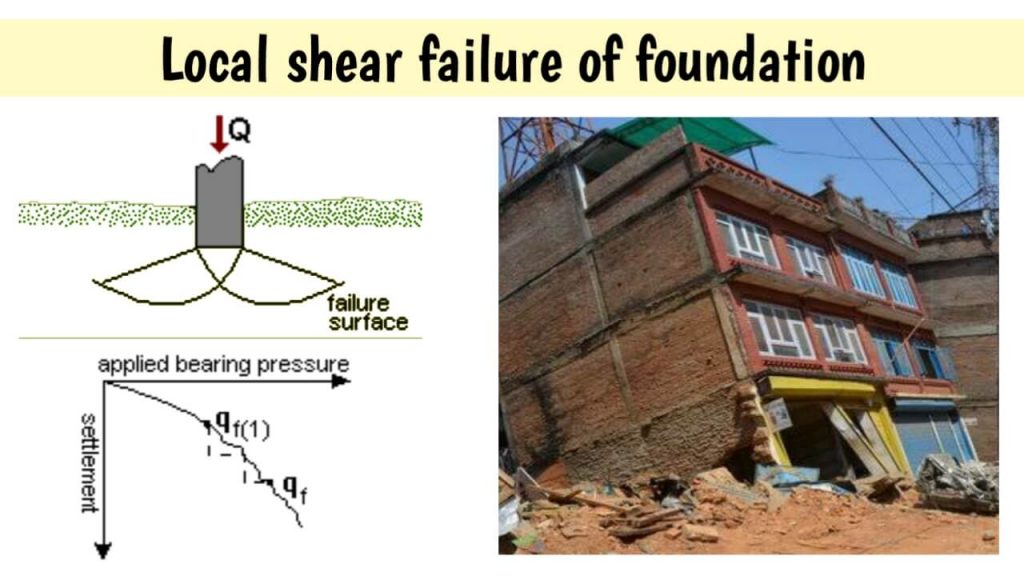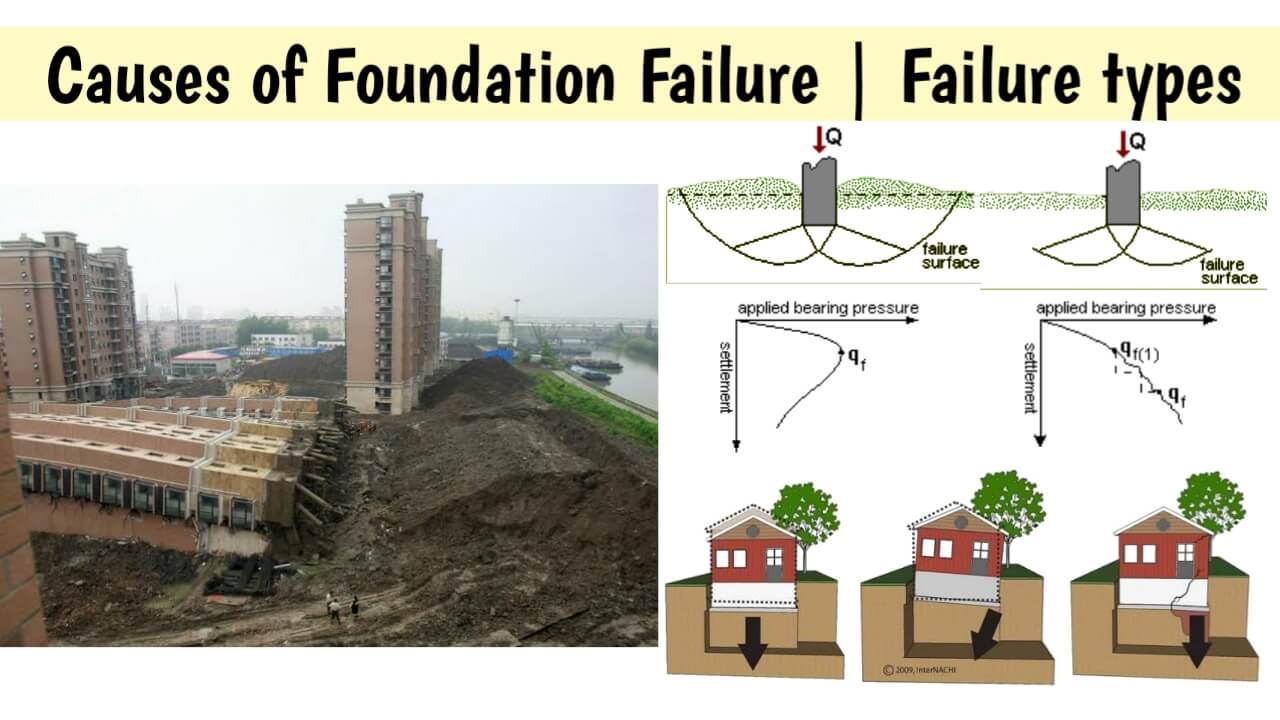In this article, we explain the major causes of foundation failure, types of foundation failures like a general shear failure, punching shear failure, local shear failure. remedies measures of foundation failure. General shear failure. we also explained remedies for foundation failure.
First of fall we explain How many types of foundation failures occur in a structure.
Table of Contents
Types of Foundation Failure:
There are three major types of foundation failure, which are listed and explained below.
- General Shear Failure
- Punching Shear Failure
- Local Shear Failure
We explain important points of foundation failures.
1. General Shear Failure:

- General shear failure has a well-defined failure pattern.
- Failure load: Well defined.
- There is a tendency for the soil adjacent to foundation to bulge.
- Failure is sudden and catastrophic.
- Failure is accompanied by the tilting of foundation.
- Generally occurs in STIFF CLAY/ DENSE SANDS at SHALLOW depths.
2. Punching Shear Failure:

- Failure pattern is not easy to observe/not well defined.
- Failure load: Not well defined (There is a continuous increase in vertical load with the vertical movement of footing. This means that Ultimate load is not clearly evident.)
- No bulging: Soil outside the loaded area is not affected.
- Failure is not catastrophic.
- No tilting. A horizontal and vertical equilibrium of footing is maintained.
- Generally occurs in SOFT CLAYS / LOOSE SANDS at SHALOW/ DEEPER depths.
3. Local Shear Failure:

- Failure pattern is clearly defined only immediately below the foundation.
- Failure load: Not well Defined.
- There is visible soil bulging on the sides of footing.
- There is no catastrophic collapse
- Tilting of foundation may or may not occur depending on the degree of denseness / relative density.
- Intermediate Mode of failure with characteristics of both General Shear Failure & Punching Shear Failure.
- Generally occurs in MEDIUM STIFF CLAY / MEDIUM DENSE SANDS at SHALLOW / DEEPER depths.
Now let discuss what are the causes of foundation failure?
Causes of foundation failure and remedies measures:
The main causes of foundation failure are as follows:
- Unequal settlement of soil
- Unequal settlement of masonry
- Subsoil moisture movement
- Lateral pressure on the super-structure
- Horizontal movement of the earth
- Transpiration of trees and shrubs
- Atmospheric action
1. Uneven settlement of soil:

It is the first common causes of foundation failure. In this foundation failure, The cracks are developed in a foundation or buildings due to the Uneven settlement of soil. Due to that, the durability of building is reduced. Also due to cracks, the reinforcement of foundation are corroded.
Causes of uneven of soil:
- Uneven distribution of load
- Change in soil Bearing capacity
- Eccentric loading etc.
Remedies measures:
- The foundation should be supported on a rock or hard surface.
- The foundation should be designed keeping in mind the type of soil.
- The pressure on the soil should not exceed Permissible bearing pressure on it.
2. Uneven settlement of masonry:

The mortar used in masonry is compressed or shrink by applying a heavy load on it before it hard properly due to that, the masonry settles unevenly.
Due to the Uneven settlement of masonry, cracks are developed in foundation which causing failure of the foundation.
Remedies measures:
- The mortar used in masonry should be exactly stiff and have the required workability.
- The masonry work should be lifted slowly together.
- If cement mortar is used in one day, the height of the wall should not exceed 1.5 m.
- The masonry should be cured properly for 10 days.
3. Sub-soil Moisture movement:
It is the one of the most common causes of foundation failure, which is mainly occur in cohesive soil.
Such a defect occurs where the Water table change it position many times. This fluctuation of ground water causes foundation failure.
If the water table Going down, compresses the soil which causes cracks in the structure. And In the case of water table going rise then the subsoil swell which developed more swelling pressure. In this case foundation have great resistance against swelling pressure otherwise foundation fail.
Remedies measures:
- In such a situation, the footing steps should be lowered down to the hard rock.
4. Lateral force applied on a super structher:
The lateral force is applied to the superstructure due to wind, earthquake. If foundation or structure is not designed to resist such forces then the foundation or structure fails due to overturning.
Remedial measures:
To prevent this type of failure, the foundation of the structure should be kept wide and lateral forces like wind, earthquake, should be taken into consideration while designing the structure.
5. Lantern movement of soil:
The soil on sloping land or river bank collapses due to horizontal or inclined force. This type of failure is occurring in soft soil or granular soil.
Remedial measures:
- Building a retaining wall.
- Lower the seat piles.
6. Evaporation by trees and shrubs:
The trees around the construction absorb water from the ground around the foundation so that the structure settles and cracks appear.
Remedial measures:
- The depth of the foundation should be kept at least 1 m.
- Fast-growing trees should not be grown at a distance of 8 m from the wall.
7. Atmospheric action:
Heavy rainfall, change in temperature, etc. cause damage to the foundation.
Remedial measures:
- The water table Can be kept low.
- After the foundation masonry is done, the sides of the trench should be filled with soil with proper compaction.
- Provide great plinth protection with proper damp proofing.
Failure of foundation trench and preventive measures:
Reasons for collapse of foundation trench walls:
- The soil is soft or loose.
- The soil is sandy.
- The depth of the foundation is high
- By making mounds of excavated soil, sand, gravel, very close to the edge on the sides of the trench.
- If the groundwater level (Ground W.T) is high.
- By moving vehicles on the road very close to the edge of the trench.
- By having mixer machine, lift etc. near the edge of the trench.
- By moving laborers near the edge of the trench.
Remedial Measures to prevent erosion of trench walls:
- Timbering of trenches should be done if the soil is loose and excavation depth is high.
- The excavated soil should be thrown at least 1 m away from the edge of the trench.
- Heaps of soil, sand, gravel, etc. should not be made near the edge of the trench.
- The road for movement of vehicles should be kept away from the trench.
- The mixer machine, lift, etc. should not be arranged near the edge of the trench.
- The movement of laborers near the edge of the trench should be stopped.
What are the main causes of foundation failure?
1. Unequal settlement of soil
2. Unequal settlement of masonry
3. Subsoil moisture movement
4. Lateral pressure on superstructure
5. Horizontal movement of the earth
6. Transpiration of trees and shrubs
7. Atmospheric action
How can you prevent foundation settlement?
Foundation settlement can be prevented by a proper analysis of ground soil, and by constructing a foundation on hard soil strata. this is the common preventative measure that should be followed by all foundations.
What are the precautions to avoid foundation failures in black cotton soil?
The following precautions should be considered in the case of Foundation in black cotton soil.
1. Try to construct foundation in the dry season.
2. Use Under reamed pile foundation for Black cotton soil
3. Use Raft Foundation for Large Structure.
4. Depth of Foundation Should be 1.5m Minimum
5. Use ties or bands at plinth level.
Also Read:


I need referance
THIS article Very helpful to us